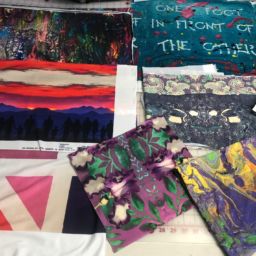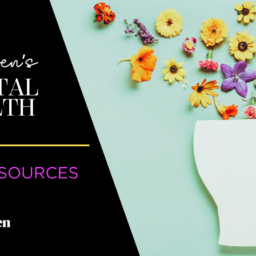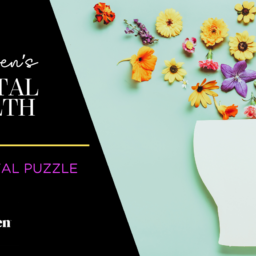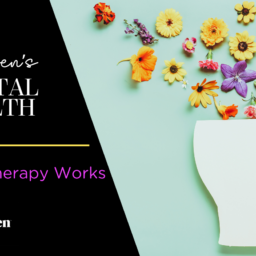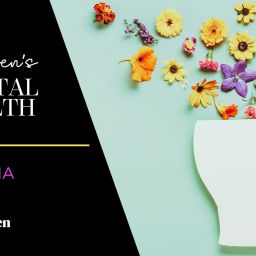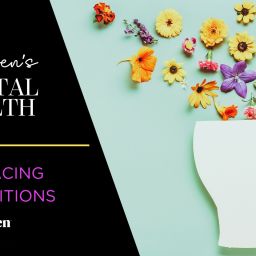
According to the American Art Therapy Association (AATA), art therapy is “an integrative mental health and human services profession that enriches the lives of individuals, families, and communities through active art-making, creative process, applied psychological theory, and human experience within a psychotherapeutic relationship.”
When facilitated by a professional art therapist, art therapy is used to improve cognitive and sensorimotor functions, foster self-esteem and self-awareness, cultivate emotional resilience, promote insight, enhance social skills, and reduce and resolve conflicts, to name a few.
There are a lot of misconceptions about what art therapy is and what it entails, so we asked four local professionals to give us their insights into their work. While some assume that art therapy is only for children, that is not the case at all; anyone can participate. Read on to find out more about what art therapy is, and how it can impact lives.

Kaitlin Knapp, MA, ATR-BC, LMHC
President, Indiana Art Therapy Association
Clinical Program Manager at Ascension St. Vincent Hospital
What made you decide to pursue a career in art therapy?
I have loved making art and looking at art my entire life and have sought ways to share the innate healing that art provides since college. I first thought the way I wanted to share art with others was through art education, but I fell in love with the psychology of education which directed me to art therapy after college. From there I found the center of all my passions, a love for art, a love for psychology, and a love for sharing both with others.
Can you describe a bit about the setting that you currently work in?
I am a Clinical Program Manager at Ascension St. Vincent Hospital in Indianapolis. It is a Level I Trauma Center for Pediatrics and Adults that sees patients of all kinds that come to us from all over Indiana. I manage a team of Creative Arts Therapists (art, music, and dance/movement therapies), Child Life, Pediatric School Program, and Pet Therapy, all of whom span across the campus to different areas such as adult inpatient, pediatric inpatient/outpatient, oncology, our NICU, surgery, and emergency departments. I do maintain a small clinical caseload of my own on-site as well, mostly working with our outpatient renal transplant population, COVID patients, and bereavement/end-of-life cases at the moment.
How do you think that art therapy impacts the lives of your clients?
I think that it allows our clients a way to look introspectively in ways they may not have thought about before. Creating art circumnavigates our natural and learned defense mechanisms and most will discover things about themselves and their goals through the creation of art and processing it with their art therapist.
What are some of the biggest challenges you have faced as an art therapist?
Advocacy continues to be a struggle, we have been working towards state licensure, title protection, and insurance reimbursement for many years now and have not been successful in passing bills. Our goal is to create legislation that protects Hoosiers and ensures they are receiving Art Therapy services from professionals with the appropriate training and credentials to practice.
Are there any misconceptions about your job that you would like to clear up?

Art therapy is not just for children and it is still therapy. When people learn that I am an art therapist, more often than not the next line they say is, “Oh, I bet that is the most fun job,” and it is, I love being an art therapist, but what many don’t think about is the tough work that goes into therapy. Even though we are incorporating art into our practice, it is still therapy, and therapy is hard. I have spent almost all of my graduate learning and professional career working with adults, with an average client/patient age being around 50 years old, which surprises a lot of people. Art is for all, and adults can benefit from art therapy in the same way children and teens can.
What does your work in art therapy mean to you?
Art therapy to me is a way to show that not all persons heal in the same way. It also allows a deeper understanding between all people—art is a universal language that can be understood and appreciated by all, regardless of age, gender, race, or disability.
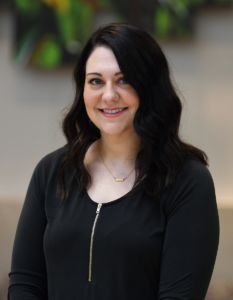
Cassie Lynn Dobbs, LPC, ATR, MAAT
Behavioral Health Counselor and Art Therapist
Riley Bereavement Services: Hope in Healing and Pathways to Healing
Riley Hospital for Children at IUHealth
What made you decide to pursue a career in art therapy?
Initially, I was a fine arts major in college. I have always had a love for making art. My freshman year of college, my dad died unexpectedly. Shortly after this loss, I felt a pull to get back in the classroom despite overwhelming support to take as much time off as I needed. But I had an unexplainable pull to get my hands on art supplies, and it was then I learned the amount of healing making art and creating could provide. I had never heard of art therapy before college, but I started looking into this feeling of healing I was experiencing and luckily discovered the profession of art therapy, which became my new career goal.
Can you describe a bit about the setting that you currently work in?
Currently I work at Riley Hospital for Children. I spent my first 7 years of my profession inpatient as a pediatric medical art therapist, which I absolutely loved. At the same time, I was drawn to working with the bereavement population, so I spent a few nights a week working at our bereavement center. In 2019 I decided to make a career move to being a full-time pediatric bereavement art therapist at Riley Bereavement Services, an outpatient program with Riley Children’s Health. I work with children who have lost siblings, parents, or other loved ones as well as parents and caregivers who have experienced the loss of a child or infant.
How do you think that art therapy impacts the lives of your clients?
I am lucky that I get to witness the impact of art therapy on my clients every week. My clients return to my office weekly or every other week, typically. This allows us the opportunity to work on long-term and thoughtful art pieces. With my population specifically, a lot of memory making items are created, a way to honor and remember their children gone too soon. But also, a way to get out all of those feelings that are difficult to express in words. Through creating, there are other options to express yourself when words are not enough.
What are some of the biggest challenges you have faced as an art therapist?
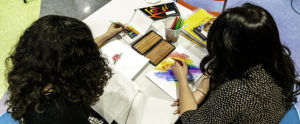
Some of the biggest challenges I have seen in my career is the understanding of what our career actually is and the scope of practice that we are capable of. We are mental health professionals, and we take all of the required psychology classes to get our licenses in the state as Licensed Mental Health Professionals. In addition to those classes, we also take classes that educate us in using art-based technique and theory and how to apply these in a mental health setting. We are advanced degree professionals with a minimum of a master’s degree required to practice. We have to abide by ethical standards of practice and obtain continuing education credits throughout our career.
Are there any misconceptions about your job that you would like to clear up?
I think there are several misconceptions. One, that we are the fun and creative people that get paid to make art with clients. While what we do in a session can certainly be fun, it can also be hard work, challenging, emotional, empowering, and complicated.
Another misconception we often see is the misuse of the term “art therapy.” I believe that a lot of people who make art at some point feel the healing power within it and they want to share that with others, which is a great sentiment. However, art making directed at healing can be very complicated and challenging. So if someone is calling themselves an art therapist or advertising they provide art therapy without the proper education, they can put those they work with in a dangerous situation as they likely do not have the expertise on how to help contain a safe space to express those emotions and how to do so safely and effectively. Protecting the term “art therapy” for those that uphold their educational standards helps to protect the community when they seek out support from an art therapist, knowing they are seeing a professional who can provide them with safe and effective practices.
What does your work in art therapy mean to you?
Being able to provide my community with support through creative healing and art therapy combines my passion for helping others and my genuine belief in the power of art making and creating as a tool to healing. I can genuinely say that I love my career and especially serving the bereavement community here in Indiana. Like any mental health career, it can be taxing and overwhelming at times, especially during a pandemic claiming so many lives and providing an even greater need for mental health support. However, as a wounded healer, being able to companion my clients on their journey is a true honor and I feel grateful they let me into their lives.
 Macey Smith, MA
Macey Smith, MA
(Macey is a recent Herron School of Art + Design graduate who has her temporary license until she tests for her LMHCA and is pending for her ATR-P)
Licensed Masters Therapist for CUMMINS BEHAVIORAL HEALTH
What made you decide to pursue a career in art therapy?
I always loved helping people and loved art, and that is what I told my high school guidance counselor when they asked. He told me about art therapy, so I checked it out and fell in love! I met with the program director at Herron School of Art + Design and knew this is what I wanted, but had no idea what to do with the four years in between high school and a master’s program. I completed my BFA in Photography at Herron and completed my Pre-Art Therapy certificate there as well. I applied to the MA program and was accepted and graduated with my master’s in art therapy in 2021.
Can you describe a bit about the setting that you currently work in?
I work for Cummins Behavioral Health as a Master’s Level Therapist in an elementary school in Wayne Township. I work with kids in kindergarten to 6th grade. I get the opportunity to work with kids, teachers, the school, and the families to help create positive change all around our clients. Most kids this age are dealing with learning routines, making friendships, and finding out who they are. ADHD, lots of energy, and big emotions can come out in an elementary school, and this is where I can come in to help kids identify those emotions, thoughts, and feelings through the use of art.
How do you think that art therapy impacts the lives of your clients?
For my clients, art allows for them to explore unapologetically and
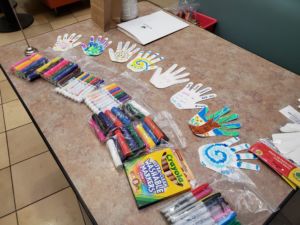
without a grade attached to it. Kids have the tendency to want to create and try new things. Kids have the same feelings that adults do, but not the same vocabulary to express it. This is where the power of art therapy comes in. My clients come in and I encourage them to express, explore, and discover their emotions through art. We learn together in a supportive space. Art truly is another form of communication, especially for these young children. Art therapy allows for them to use big gestures, bright colors, or just to slow down for a bit. They learn that they have the power to control and express their emotions, with a splash of encouragement and support.
What are some of the biggest challenges you have faced as an art therapist?
As an art therapist, I think a tough challenge is always advocating and educating others. While we love to do this, sometimes I wish that art therapy was more commonly known and discussed here in the Midwest. Art therapy is still in the uphill climb era. Professionals young and old come together to blaze these trails and it can be tiring. We know how great this profession is and how much it helps others, but it can take convincing sometimes.
Are there any misconceptions about your job that you would like to clear up?
Even though it is 2022, I am still amazed at how some people may view art therapy as “needing art skills” or meant just for kids. As I said earlier, art is a form of communication. Civilizations before us used art to communicate, and that has not changed much. Some families can come in with the idea that art therapy is about skill and craft, but this is so far from the truth. We are not here to judge, and no previous knowledge is needed. Art therapists can teach art skills and processes and often encourage their clients to try something new, even if it is to help reach goals or just to play. Also, I think art has a natural relationship with kids. Yes, I work in an elementary school, but I have interned at a place where art therapy was used for populations ages 6-66+ and it is beautiful at every stage of life.
What does your work in art therapy mean to you?
My work in art therapy means knowing that I have the gift to communicate and empower clients in more ways than just words. I am coming in each session open-minded to new ideas, new processes, and new topics. I have the ability to meet my clients where they are and hold that space for them when others, or even themselves, may not be able to. It really does feel like you have this invisible toolkit with you. Art therapy has also been that healing and growing opportunity for me on a personal level. I use it in my own personal therapy, because yes, even therapists need therapists!

Michelle Itczak, MA, ATR-BC, LMHC
Assistant Professor Practicum and Internship Coordinator at The University of Indianapolis
What made you decide to pursue a career in art therapy?
For me, it was a combination of life circumstances. When I was a child I had several experiences with medical diagnoses, including chronic illness. Unbeknownst to me at the time, I used art as a way to cope with those experiences. My mom is a nurse, so I was raised with compassion and a desire for helping people, but I wanted to do it with art. In high school I did an AP English paper about a field I was interested in and I discovered art therapy. Essentially, I wanted to be a person who could help others through challenging times and I wanted to use art as a way to do it.
Can you describe a bit about the setting that you currently work in?
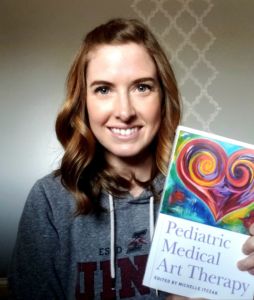
My primary role is as an art therapy educator. I am an assistant professor and the practicum and internship coordinator at the University of Indianapolis in our Master’s program. I also continue some clinical work at a private practice and through the Hope in Healing program through Riley Bereavement Services. In my private practice, I work primarily with adolescents and women in their 20s, 30s, and 40s. Concerns that clients bring include anxiety, grief, and loss, as well as many other topics. At Hope in Healing, I work with family members who have lost a child or sibling, typically from a medical diagnosis such as cancer.
How do you think that art therapy impacts the lives of your clients?
Art therapy gives my clients a new and different way to express themselves. It can help them find a “voice” for their thoughts and feelings that are so hard to verbalize. Sometimes it helps them discover things about themselves that they weren’t aware of to begin with. I also love that art therapy provides them with a visual, tangible record of the hard work they put into therapy. It’s not easy to do the work needed to make changes and address mental health, but seeing and touching the artwork can be a great reminder of just how far a client has come.
What are some of the biggest challenges you have faced as an art therapist?
Definitely one of the biggest challenges in Indiana is dealing with people’s assumptions of what art therapy entails. Many people have misconceptions about our field and the media often misrepresents what we do, which creates challenges when trying to encourage people to seek services.
Are there any misconceptions about your job that you would like to clear up?

It’s really important that people find out about a person’s training in art therapy before accepting them as a therapist. Unfortunately, there are a lot of people who claim to be art therapists or expressive art therapists who don’t actually have a true degree in art therapy. People who aren’t properly trained and who don’t understand the nature and potential of art materials can cause more harm than good, especially when working with mental health issues. Art therapists don’t “read” your artwork or give a diagnosis to someone based on a single picture. We work with our clients to help them figure out the meaning in their own work. We also don’t expect people to create beautiful masterpieces in art therapy.No talent is required to participate in art therapy. Also, coloring books are NOT art therapy.
What does your work in art therapy mean to you?
My work in art therapy is a way to use my unique talents to contribute to my community, society, and the world, making it a better place. It is a chance to make a difference in the lives of the people with whom I am blessed to work. As a practicing art therapist, I love to use art and my helping skills to help people improve their lives. As an art therapy educator, I love teaching others how to do this work so that the benefits of art therapy are multiplied and reach further than I ever could as a single therapist.
Stephanie Groves is the Executive Editor of Indy Maven.
All of our content—including this article—is completely free. However, we’d love if you would please consider supporting our journalism with an Indy Maven membership.











